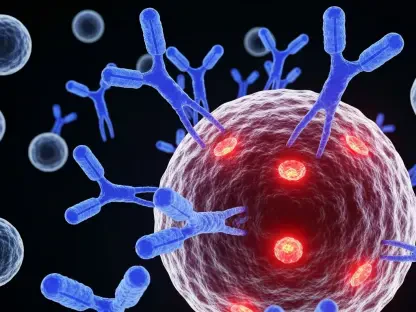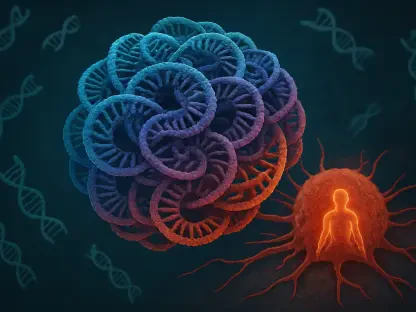The ongoing quest to treat mitochondrial diseases has achieved a revolutionary stride, enhancing possibilities within gene therapy landscapes through mitochondrial base editing (mtBE). Recent innovations by scientists at the University Medical Center Utrecht signify a substantial advancement in correcting mitochondrial DNA mutations. Traditional gene editing tools like CRISPR, while groundbreaking, have stumbled when addressing mitochondrial DNA due to their inability to penetrate the mitochondrial membrane. This new mitochondrial base editing technique, developed under the guidance of Martijn Koppens, PhD, introduces an innovative mechanism that offers precise edits without the need for cuts to the genetic material.
Addressing Genetic Disorders with Novel Techniques
Revolution of Mitochondrial Base Editing
Mitochondrial base editing emerges as a pivotal method, transforming the genetic medicine landscape. The technique harnesses a double-stranded DNA deaminase toxin A-derived cytosine base editor (DdCBE) to effect targeted modifications within the mitochondrial genome. Unlike traditional CRISPR approaches that rely on cutting DNA, this method precisely alters mitochondrial DNA sequences, generating sustained changes in experimental setups.
Research utilizing patient-derived disease models has validated the technique’s capabilities. Successful generation and correction of mitochondrial mutations across diverse cell types demonstrate its clinical promise. Notably, liver cells were modified to harbor mutations, affecting energy production. By creating organoids exhibiting various mutation levels, researchers explored the ramifications on ATP production, reflecting mitochondria’s critical function in cellular energy generation. These advancements in modeling extend beyond theoretical research, propelling therapeutic applications closer to clinical reality.
Exploring Clinical Applications
The journey to address mitochondrial diseases through this innovative technology involves meticulous exploration of clinical settings. Real patient-derived cells have benefited from this technique, including reversing mutations linked to Gitelman-like syndrome in skin cells. Restoration of mitochondrial membrane potential within these cells further substantiates mtBE’s therapeutic potential, showcasing high specificity and purity as hallmarks of the DdCBE approach. This precision raises hopes for dependable therapeutic tools in tackling mitochondrial disorders.
Integral to this research are the delivery methods that ensure efficiency and safety. Delivering mitochondrial base editors in mRNA form exhibits increased cellular viability compared to conventional DNA-based strategies. Supplemented by lipid nanoparticle delivery systems, these methods stand at the forefront of non-viral gene therapy approaches. Such technological convergence offers prospects for less toxic, more efficient patient interventions, hinting at a promising trajectory for in vivo gene therapy within mitochondrial research realms.
Enhancing Gene Therapy Through Advanced Techniques
Challenges in Mitochondrial Editing
Despite significant successes, challenges persist in ensuring the accuracy and minimizing off-target effects of mitochondrial base editing. Although current methods demonstrate minimal disruptions, particularly regarding nuclear DNA, ensuring precision remains crucial. The ability of DdCBE to introduce mutations without unwarranted edits remains a focal point, demanding ongoing refinement. Researchers continue to prioritize the precision required for clinical application, with future exploration directed toward optimizing targeting mechanisms to secure reliable results.
The pursuit of precision also highlights the significance of patient safety in gene therapy applications. By honing delivery systems and targeting methodologies, researchers strive to mitigate risks associated with unintended genetic alterations. Addressing these challenges paves the way for broader therapeutic implementations, seeking to strike a balance between innovation and safety within mitochondrial gene therapy domains.
Future Outlook and Implications
The path forward for mitochondrial base editing holds immense potential, offering new frontiers for research and treatment. With the advent of efficient delivery mechanisms and refined targeting techniques, gene therapy stands on the brink of transforming mitochondrial disease treatment. Achieving successful therapeutic interventions requires ongoing efforts to enhance accuracy and reliability while reducing risks.
The approach to modeling mitochondrial diseases through base editing not only broadens scientific understanding but also propels therapeutic endeavors. It sets the stage for interventions that could fundamentally alter treatment courses for mitochondrial disorders, empowering researchers to unlock treatment possibilities beyond traditional frameworks. Collaborations within scientific communities stand poised to translate these breakthroughs into tangible clinical progress, heralding a new era in genetic medicine.
Impacts and Reflections
Bridging Research and Therapeutic Potential
The exploration of mitochondrial base editing encapsulates a dynamic blend of scientific inquiry and potential therapeutic breakthroughs. As researchers delve deeper into the intricacies of mitochondrial DNA alterations, they uncover a realm ripe with possibilities for tackling complex genetic disorders. By extending successful trials from laboratory settings into clinical applications, the potential for changing the landscape of mitochondrial medicine grows evermore tangible.
This method not only redefines mitochondrial disease modeling but also charts new territories for therapeutic interventions. Addressing genetic disorders through precise mitochondrial targeting elevates genetic medicine, blending molecular innovation with clinical aspiration. By establishing robust methodologies for delivery and precision, scientists chart a course toward transforming therapeutic paradigms, offering a beacon of hope to countless patients.
Looking Ahead
The pursuit of treatments for mitochondrial diseases has made significant progress, enhancing gene therapy opportunities through mitochondrial base editing (mtBE). Researchers at University Medical Center Utrecht have developed a technique that addresses mitochondrial DNA mutations, marking a noteworthy advancement. While traditional gene editing tools like CRISPR have revolutionized genetic modification, their effectiveness with mitochondrial DNA has been limited due to their inability to breach the mitochondrial membrane. This novel mitochondrial base editing technique, overseen by Martijn Koppens, PhD, introduces an innovative method allowing precise genetic edits without incisions to the DNA itself. By circumventing traditional barriers and offering a more nuanced and targeted approach, mtBE is set to change the landscape of mitochondrial disease treatment, providing new hope for those affected by these genetic disorders and expanding the potential applications of gene therapy.









